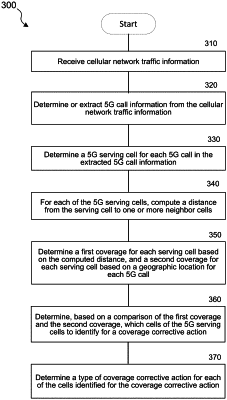| CPC H04W 24/02 (2013.01) [H04W 16/28 (2013.01); H04W 64/003 (2013.01)] | 20 Claims |

|
1. At least one computer-readable storage medium, excluding transitory signals and carrying instructions, which, when executed by at least one data processor of a system in a cellular network, cause the system to:
receive cellular network traffic information,
wherein the cellular network traffic information comprises geolocated call data corresponding to one or more radio access technologies (RATs), and
wherein the cellular network traffic information comprises Evolved Universal Mobile Telecommunications System Terrestrial Radio Access Network (EUTRAN) New Radio (NR) dual connectivity (EN-DC) cellular network traffic information or a non-standalone (NSA) NR cellular network traffic information;
determine, from the cellular network traffic information, one or more calls from mobile devices connected to the cellular network, wherein the one or more calls correspond to an NR RAT;
determine a serving cell for each call in the one or more calls;
compute a distance from the serving cell to one or more neighbor cells;
determine a first coverage for the serving cell based on the distance from the serving cell to the one or more neighbor cells;
determine a second coverage for the serving cell based on a geographic location of each mobile device corresponding to the one or more calls corresponding to the NR RAT;
determine whether to identify the serving cell for a corrective action based on a comparison between the first coverage and the second coverage, and further based on whether a signal strength of each one of the calls is above a threshold; and
determine a type of corrective action for the serving cell, wherein the type of corrective action comprises an antenna down tilt, an antenna up tilt, or a power reduction.
|